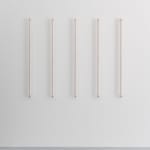Lou Jaworski
L.A., 2021
Handcut and polished marble and aluminum
5 parts, each 125 x 3 cm
49 1/4 x 1 1/8 inches
49 1/4 x 1 1/8 inches
Copyright The Artist
Photo: Dirk Tacke
Weitere Abbildungen
Lou Jaworskis Wandarbeit „L.A.“ (2021) erinnert auf den ersten Blick an handelsübliche Neon-Leuchtstoffröhren, erst beim Nähertreten ist erkennbar, dass es sich um Stäbe aus rosafarbenem Marmor handelt. Jaworski lotet in...
Lou Jaworskis Wandarbeit „L.A.“ (2021) erinnert auf den ersten Blick an handelsübliche Neon-Leuchtstoffröhren, erst beim Nähertreten ist erkennbar, dass es sich um Stäbe aus rosafarbenem Marmor handelt. Jaworski lotet in seinen Arbeiten häufig die Grenzen von Materialien aus. In „L.A.“ schneidet er dünne Zylinder aus dem Portogallo Rosso und gibt der massiven Materialität des Steins die zerbrechliche Eigenschaft von Glas. Wie ein leichter Schimmer zieht sich ein zartes Rosa durch den Marmor, der aus der portugiesischen Küstenregion kommend, die auf- und untergehende Sonne andeutet. Durch die horizontale Anordnung der fünf Röhren entsteht der Eindruck eines Raumes, der beleuchtet werden soll und richtet das Augenmerk auf die umliegende Architektur, auf die „L.A.“ einwirkt. Das Aufkommen von Neonlicht hatte – vorrangig in öffentlichen Gebäuden und im Stadtbild – Auswirkungen auf die Wahrnehmung von Räumen und wie diese, durch flächendeckende, farbige Beleuchtung oder Schriftzüge, gestaltet wurden. Den perzeptiven Einfluss von Neonlicht auf das alltägliche Leben wurde von Künstler/innen in kreative Prozesse aufgenommen und steht heute in einer langen materialästhetischen Tradition. Jaworski greift dies auf und überführt das serielle Industrieprodukt der Leuchtstoffröhre in handwerklichem Geschick zurück, in das traditionellste skulpturale Material, den Stein und schafft somit eine Ambivalenz zwischen Materialität, Wertigkeit und industriellem Fortschritt.
L.A, 2021
At first glance, Lou Jaworski's wall piece L.A. (2021) resembles standard neon fluorescent tubes; only upon closer inspection is it apparent that they are actual pink marble columns. Jaworski often explores the limits of materials in his work. In L.A., he cuts thin cylinders out of Portogallo Rosso, giving the solid materiality of the stone the fragile quality of glass. With a light shimmer, a delicate pink stain runs through the marble, which, coming from the Portuguese coastal region, hints at the rising and setting sun. The horizontal arrangement of the five tubes creates the impression of an illuminated space and focuses attention to the surrounding architecture directly impacted by L.A.. The advent of neon lighting had an impact – primarily in public buildings and in the cityscape – on the perception of spaces and how they were designed, through a blanketed, colored lettering. The perceptive influence of neon light on daily life has been utilized by artists in their creative processes and is part of a long material-aesthetic tradition. Jaworski references these and transfers the serial industrial product of the fluorescent tube back into the most traditional sculptural material, stone, thus creating a perceptive ambivalence between materiality, value and industrial progress.
L.A, 2021
At first glance, Lou Jaworski's wall piece L.A. (2021) resembles standard neon fluorescent tubes; only upon closer inspection is it apparent that they are actual pink marble columns. Jaworski often explores the limits of materials in his work. In L.A., he cuts thin cylinders out of Portogallo Rosso, giving the solid materiality of the stone the fragile quality of glass. With a light shimmer, a delicate pink stain runs through the marble, which, coming from the Portuguese coastal region, hints at the rising and setting sun. The horizontal arrangement of the five tubes creates the impression of an illuminated space and focuses attention to the surrounding architecture directly impacted by L.A.. The advent of neon lighting had an impact – primarily in public buildings and in the cityscape – on the perception of spaces and how they were designed, through a blanketed, colored lettering. The perceptive influence of neon light on daily life has been utilized by artists in their creative processes and is part of a long material-aesthetic tradition. Jaworski references these and transfers the serial industrial product of the fluorescent tube back into the most traditional sculptural material, stone, thus creating a perceptive ambivalence between materiality, value and industrial progress.











